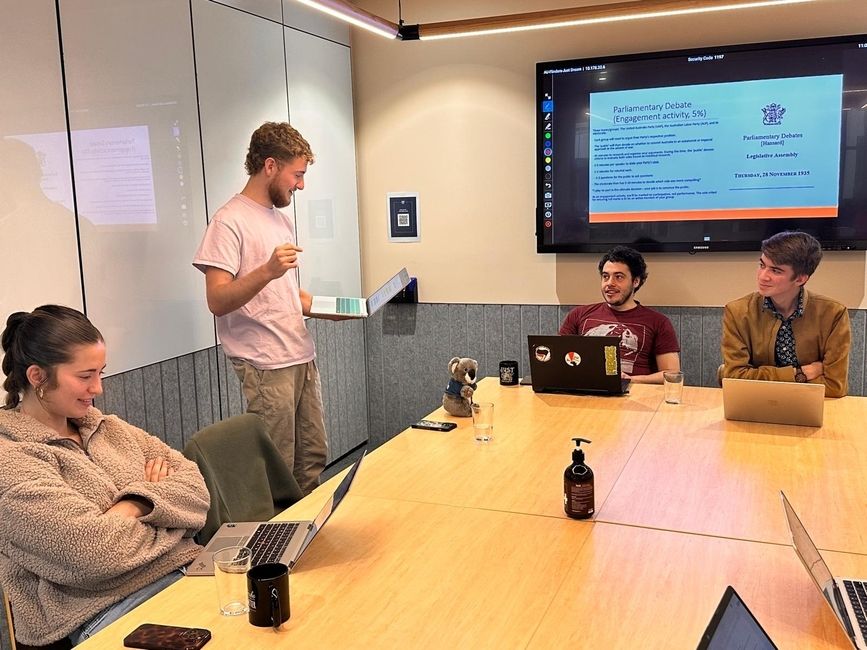Differences between US & Australian academic culture
Study abroad is meant to be different to what you are used to back home. So be prepared for differences in and out of the classroom.
Academic Calendar
- Australia: The academic year is aligned to the calendar year eg: from February to November, divided into two semesters.
- U.S.: Runs from August to May, often with two semesters and optional summer sessions.
Vocabulary
- In Australia: a course is the overall degree e.g. Bachelor of Business, is your course.
- You don’t take a class, you take a subject. Your subjects make up your course, usually 4 subjects a Semester. The term “class” is more widely used for elementary or high school.
- In each subject there will likely be a combination of lectures, workshops, tutorials, labs, practicums depending on what you are studying.
- the Add/Drop date in Australia is called the census date. It’s the last date to change your mind about your enrolment in a subject without financial penalty.
Teaching and Learning Style
- Australia: Emphasizes independent learning. Students are expected to take initiative, read widely beyond lectures, and manage their own time. Lectures are often less interactive, with tutorials or seminars used for discussion. You are expected to come to class informed and ready to contribute.
- U.S.: More structured and participatory. Classes often include regular assignments, quizzes, and class participation. Professors may be more accessible and involved in students’ academic progress.
Assessment and Grading
- Australia: Fewer assessments with heavier weighting (e.g., a final exam might be worth 60–70% of the grade). There’s a strong emphasis on critical thinking and essay writing.
- U.S.: More continuous assessment—midterms, finals, papers, presentations, and participation all contribute to the final grade. GPA is cumulative and important for future opportunities.
Campus Life and Extracurriculars
- Australia: University is often seen more as a place for study than a lifestyle. Most students will choose a University in their home town, live at home or in shared houses and commute. It is not very common for students to live on campus - that is usually reserved for international students or those from rural, regional Australia, or the few who have chosen to study in another city from their own.
- U.S.: Campus life is a major part of the experience. Students often live on campus, and there’s a strong emphasis on clubs, sports, and Greek life.
Cost and Funding
- Australia: Public universities are subsidized, and domestic students can defer their tuition and pay later via a higher education tax once they start earning a salary, called a HECS-debt. International students pay up front and fees are usually higher. Scholarships are not very common.
- U.S.: Tuition is generally higher, especially at private institutions. Financial aid and scholarships are more common but can be complex.
Academic Titles and Hierarchies
- Australia: Uses British-style academic titles (e.g., “Lecturer,” “Senior Lecturer,” “Associate Professor,” “Professor”, "Tutor").
- U.S.: Uses a different hierarchy (e.g., “Assistant Professor,” “Associate Professor,” “Professor”).
Related Posts

EAT, DRINK, EXPLORE: SYDNEY
BEST FOOD TO EAT IN SYDNEY While in Sydney, a stop at Black Star Pastry for a slice of their signature Strawberry Watermelon Cake is practically mandatory. The bakery opened... keep reading

Eat, Drink, Explore: Melbourne
@cieestudyabroad Eat, Drink, Explore: Melbourne, Australia Check out our NEW study abroad programs in Melbourne in our bio! #ciee #cieestudyabroad #studyabroad #melbourne #australia #eatdrinkexplore Show Me How - Men I... keep reading

From Learner to Leader
Garrett, from Western Washington University, Summer 2025 Intern in Melbourne "I leave this internship not only with a stronger resume but with a stronger sense of capability and confidence.” My... keep reading

